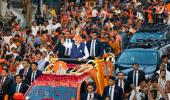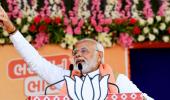That AAP managed a sizeable vote share in Gujarat is creditable.
The BJP can no longer ignore AAP's growing presence in its strongest bastion, explains Ramesh Menon, long-time observer of Gujarat politics.

The Bharatiya Janata Party swept back to power in Gujarat in one of its biggest wins for the seventh successive time. It has won every assembly election since 1995.
In 2017, the BJP got a vote share of 49.1 per cent while the Congress secured 41.4 per cent. In this election, the BJP vote share increased to over 53 per cent and the Congress vote share had plummeted to around 27 per cent.
It was the worst ever performance of the Congress which was expected given its seeming apathy and indifference in the election giving up the battle.
With the Opposition vote splitting between the Congress and Aam Aadmi Party, the BJP gained in both south Gujarat and Saurashtra.
The Aam Aadmi Party did not win many seats, but it registered a presence for the first time in Gujarat getting over 12 per cent of the votes which would otherwise have gone to the Congress.
AAP showed its growing influence in both rural and urban seats.
Though AAP was third in the race, it established how it is slowly emerging as a pan-national power with the clout of the Congress consistently diminishing with every election.
The BJP should be worried as AAP is clearly going to be the main opposition for the BJP and the threat in the future. In close door meetings, BJP leaders have bookmarked that reality.
Despite every possible cabinet minister campaigning in the Delhi municipal elections, AAP ended 15 years of the BJP's stay in office, increasing its vote share from 26.2 per cent in the last election to 42.1 percent.
Elections in Gujarat have been a colourful and power-packed affair for the last three decades. The state was the veritable laboratory of the Bharatiya Janata Party, and the nation witnessed how from Gujarat, they stole a march on the Indian political horizon.
But this time, the punch was missing though there was a three-cornered contest with the Aam Aadmi Party throwing its hat in the ring.
There were no signs of a healthy democracy throbbing or even a healthy contest brewing. Identity politics, religion, caste and communalism continued to dictate how voters were swayed as politicians made capital of it.

Everyone knew that the BJP, with its muscle power and financial clout, was way ahead despite the anti-incumbency hanging over it.
AAP managed to attract supporters as it ignited the imagination of angry and distressed small traders and businessmen, dissatisfied government employees, commoners weighed down by rising prices and the new voters pining for change.
The BJP knew it was not going to be an easy walkover. The party drafted in five of its chief ministers, 40 central ministers and 150 ministers from neighbouring states to campaign.
It was not taking the election for granted in Modi's home state.
Home Minister Amit Shah promised to create 2 million jobs from which 100,000 women would benefit. Gujarat, he said, would be a $1 trillion economy and a hub for FDI at various rallies.
Gujarat is an urbanised state with 84 of its 182 assembly seats in urban areas. Therefore, the BJP concentrated on these constituencies as they were its pockets of influence in previous elections.
The BJP had cleverly wooed Congress leaders like Hardik Patel, who led a vociferous agitation against the BJP in 2015, demanding that Patidars get a better deal in terms of reservations, jobs and concessions.
Hardik faced a tough contest in Viramgam, facing sitting MLA Laka Bharwad of the Congress and Amarsinh Thakor of AAP. As it was a prestigious contest for the BJP, it drafted in two chief ministers, Yogi Adityanath of Uttar Pradesh and Himant Biswa Sarma of Assam, to campaign for Hardik. It helped him win.
Hardik was a prize catch for the BJP, who pulled it off as the Congress gave him the cold shoulder as party insiders were cagey of his growing popularity among the Patels.
That the Patels are one of the most wealthy and influential pressure groups, constituting 13 per cent of the state's population, is another story.
The Patels have dominated the political stage for many years. Fifteen per cent of the state cabinet comprises Patels. In the business community, they are powerful and influential.
For the last three decades, Patels have primarily backed the BJP.
It was only in 2017 that Patels backed the Congress due to the agitation helping the party win 77 seats reducing the BJP's tally to 99.
Getting Hardik to cross over to the BJP was a ploy to win back the Patel vote. It worked.
Hoping to neutralise the anger against the BJP, the government granted 10 per cent reservation among the economically weaker sections helping many Patels who had not climbed the social ladder like others in their community who moved from farming to business entrepreneurship.
The BJP also replaced Chief Minister Vijay Rupani with Bhupendra Patel in its bid to woo the Patels.
The BJP fielded 44 candidates from the Patel community this time. The AAP, which has a lot of Patels as leaders, fielded 46 of them. A section of the Patels vote moved to AAP this time.
The BJP gambled on a bold strategy this time to field 41 first-time candidates rather than repeating sitting MLAs.

The idea was to fight anti-incumbency and also to reward loyal party workers.
For example, Harshad Patel fielded from Sabarmati was the party's general secretary in the state since the nineties. He mopped up nearly 75 per cent of the votes.
Jitu Bhagat, the Naranpura candidate, was the BJP's Ahmedabad city general secretary for over 40 years and garnered nearly 84 per cent of the votes.
In Ahmedabad, 12 of the 14 assembly constituencies had new faces.
At meetings, Amit Shah told voters that though they were not faces seen on television screens, they were workers who had built the world's largest political party.
Most of the new faces had managed to mop up a large percentage of votes.
There were numerous factors that the BJP was fighting against: Public anger against the Morbi bridge collapse killing 135 people, inflation, lack of education and health infrastructure, poor development indices, unhappy farmers, unemployment, remission of convicts in the Bilkis Bano case.
The Congress could have given the BJP a running contest, but it just chose to give up the battle before it started. It almost won the last assembly election in 2017, winning 77 seats despite a belligerent BJP.
It also suffered from a loss of credibility as many of its leaders and foot soldiers left after the party lost in 2017 as they did not see any hope. Between 2018 and 2019, as many as 20 Congress MLAs joined the BJP.
The Congress promised a monthly unemployment allowance of Rs 3,000, a pension of Rs 2,000 to widows, senior citizens and needy women, a loan waiver of up to Rs 300,000 for fishermen and even said they would restore the original name of the Sardar Patel stadium in Motera, Ahmedabad, which has been renamed the Narendra Modi stadium.
Old-timers in the Congress remembered how the party had swept the assembly polls in 1985 winning 149 seats. But, it was something that it cannot expect anymore. The party ran a low-profile campaign, and no one knew who would be the chief minister in case it won. Rahul Gandhi campaigned only once in the state as he was busy with his Bharat Jodo Yatra.;
In contrast, Prime Minister Narendra Modi was all over the place daily, with a massive entourage of cabinet ministers from the Centre and the state in a very loud and aggressive campaign. Both Modi and Shah addressed as many as 120 rallies. They were not taking the elections for granted.
Losing in his home state would be a national loss of face for Modi and the BJP and could have national repercussions.
Eighty-year-old Congress President Malikarjun Kharge gave a new handle to the BJP to whip up emotions when he compared Modi with Raavan.
Modi capitalised on it, saying the Congress had insulted Gujaratis by calling him Raavan and reminded them that they had earlier called him a chaiwala,mneech aadmi and whatnot.

The level of political debate during the elections was crass and mediocre, skirting real issues of price rise, unemployment, a post-Covid crisis that business establishments faced, and so on.
The Congress could have orchestrated all these, but did not seem interested in a contest.
Delhi Chief Minister Arvind Kejriwal, AAP's only recognisable and relatable face, knew well that he would not sweep the elections. That is why he made wild promises that would have put the state in a dire financial whirlpool.
Among them was 300 free units of electricity, free education in government schools, an unemployment dole, and Rs 1,000 to all women. There are 11.5 million women voters in the state.
He succeeded in displaying that his party had the courage to fight in one of the most difficult states for a new party attracting a sizeable vote share.
Kejriwal is looking at the 2027 assembly election in Gujarat. Just the way he seized Delhi and Punjab.
That AAP managed a sizeable vote share is creditable. That his party could light the imagination of voters for change and good governance should worry the BJP. It can no longer ignore AAP's growing presence in the strongest BJP bastion
The reality that the BJP needed the prime minister travelling all over the state, addressing rallies in every nook and corner the party wanted, showed the crisis in the state leadership.
Modi knew it and kept harping on what he had done for the state as its chief minister and how the state would continue to grow with the double engine strategy of the BJP being in power both at the Centre and in the state.
Kharge hit out at the double-engine theory, asking why Gujarat then had three chief ministers in six years. Former CM Rupani did not even get a ticket.
That there was urban cynicism towards the election process was evident when the voting percentage dipped by 6 per cent as compared to the last election in 2017. In urban areas, there were many who apparently chose not to vote.
In fact, it was the worst turnout since 2012. In Ahmedabad, for instance, the turnout was just 53.84.
The new Gujarat government needs to worry about delivering the quality of governance that the business-minded Gujarati wants. Though voters are heavily polarised politically and communally, the Gujarati on the street wants peace, so business can flourish and policies for unhindered growth.
It is time for the new government to actually work towards developing the state in a holistic way. Right now, it is one of the leading states as far as industry and commerce are concerned, but is woefully backward as far as development indices are concerned.
According to the Niti Aayog among other government agencies, Gujarat is 19th among 30 states in infant mortality, 29th in underweight children, 26th in stunted children, 18th in using improved sanitation facilities, 19th in girls attending school, 18th in girls being married before 18 years, 24th in school drop-outs, 27th in plastic waste generation, and 23rd in wasted children.
It has to work on these areas if Gujarat has to truly become a model of development and not a mere slogan it has been mouthing since 2012.
Ramesh Menon, award-winning journalist, educator, documentary film-maker and corporate trainer, is the author of Modi Demystified: The Making Of A Prime Minister.










